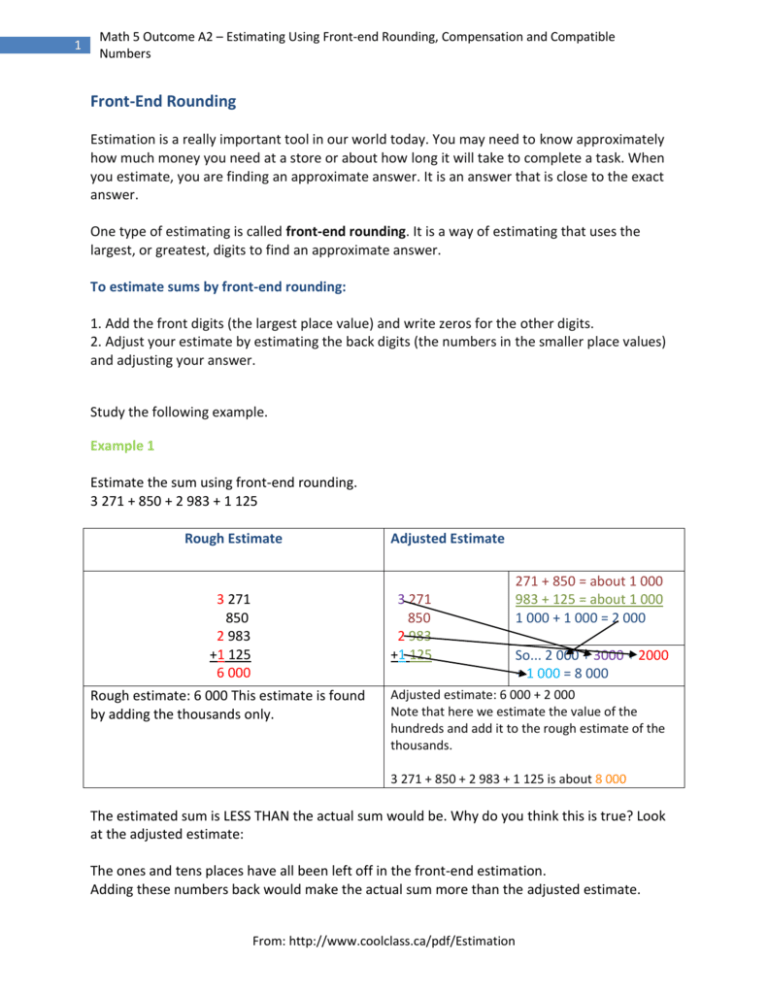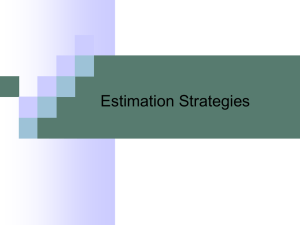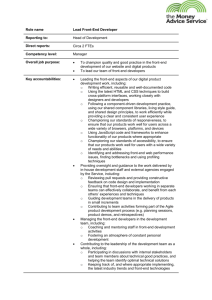Math 5 Outcome A2 * Estimating Using Front
advertisement

1 Math 5 Outcome A2 – Estimating Using Front-end Rounding, Compensation and Compatible Numbers Front-End Rounding Estimation is a really important tool in our world today. You may need to know approximately how much money you need at a store or about how long it will take to complete a task. When you estimate, you are finding an approximate answer. It is an answer that is close to the exact answer. One type of estimating is called front-end rounding. It is a way of estimating that uses the largest, or greatest, digits to find an approximate answer. To estimate sums by front-end rounding: 1. Add the front digits (the largest place value) and write zeros for the other digits. 2. Adjust your estimate by estimating the back digits (the numbers in the smaller place values) and adjusting your answer. Study the following example. Example 1 Estimate the sum using front-end rounding. 3 271 + 850 + 2 983 + 1 125 Rough Estimate 3 271 850 2 983 +1 125 6 000 Adjusted Estimate 3 271 850 2 983 +1 125 Rough estimate: 6 000 This estimate is found by adding the thousands only. 271 + 850 = about 1 000 983 + 125 = about 1 000 1 000 + 1 000 = 2 000 So... 2 000 + 3000 + 2000 + 1 000 = 8 000 Adjusted estimate: 6 000 + 2 000 Note that here we estimate the value of the hundreds and add it to the rough estimate of the thousands. 3 271 + 850 + 2 983 + 1 125 is about 8 000 The estimated sum is LESS THAN the actual sum would be. Why do you think this is true? Look at the adjusted estimate: The ones and tens places have all been left off in the front-end estimation. Adding these numbers back would make the actual sum more than the adjusted estimate. From: http://www.coolclass.ca/pdf/Estimation 2 Math 5 Outcome A2 – Estimating Using Front-end Rounding, Compensation and Compatible Numbers Estimating differences using front-end rounding is similar, but there is no adjusted estimate with the back digits. To estimate differences using front-end rounding: 1. Subtract the front digits. 2. Write zeros for the other digits. Example 2 Estimate the difference using front-end rounding. 9 354 – 3 691 Subtract the front digits: Write zeros for the other digits: The estimated difference is: 6 000. Compensation A strategy that can be used for estimation is compensation. This is a process where you take part of the value of one number and give it to another number to help in solving the problem. It is usually performed mentally but you can also use pencil and paper to work it out. Study the following example. Example 2 Find the sum using compensation: 6 + 9 Borrow 1 from the 6 and add it to the 9. (6 – 1 = 5 and 9 + 1 = 10) The problem then becomes 5 + 10. Solve the problem. This is simpler than the original problem. 5 + 10 = 15 6 + 9 = 15 Compatible Numbers Another estimating strategy in this lesson is using compatible numbers to solve the problem. This is a way to estimate answers in division problems. These numbers are easy to compute mentally. Two numbers are compatible if one divides evenly into another To estimate answers to division problems using compatible numbers: 1. Choose a basic fact that relates to the problem. From: http://www.coolclass.ca/pdf/Estimation 3 Math 5 Outcome A2 – Estimating Using Front-end Rounding, Compensation and Compatible Numbers 2. Divide. Study the following examples. Example 3 Estimate the answer using compatible numbers. 3 175 ÷ 4 Think of a basic fact that relates to the problem: 32 ÷ 4 = 8 Divide: 3 200 ÷ 4 = 800 3 175 ÷ 4 is about 800 Example 4 Estimate the answer using compatible numbers. 16 793 ÷ 4 Think of a basic fact that relates to the problem: 16 ÷ 4 or 20 ÷ 4. You may use different sets of numbers to estimate an answer. Divide: 16 000 ÷ 4 = 4 000 20 000 ÷ 4 = 5 000 Both estimates are correct and the answer will be between 4 000 and 5 000. 16 793 ÷ 4 is between 4 000 and 5 000. From: http://www.coolclass.ca/pdf/Estimation









